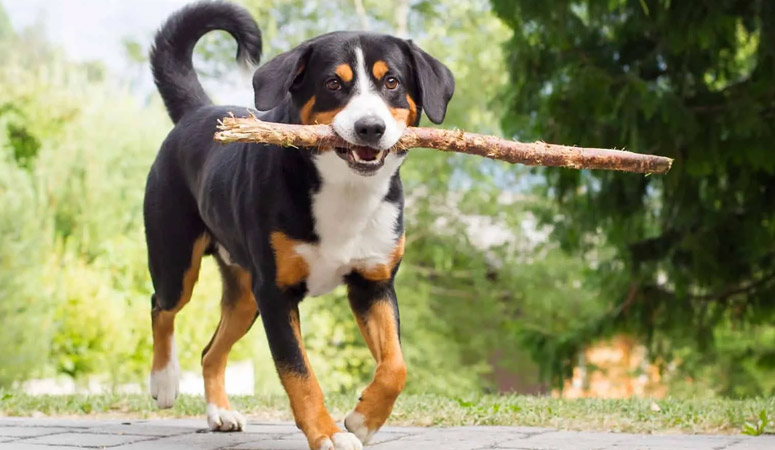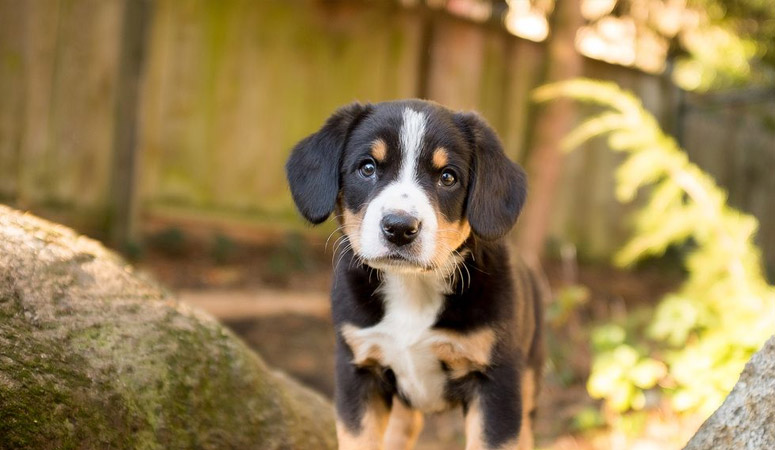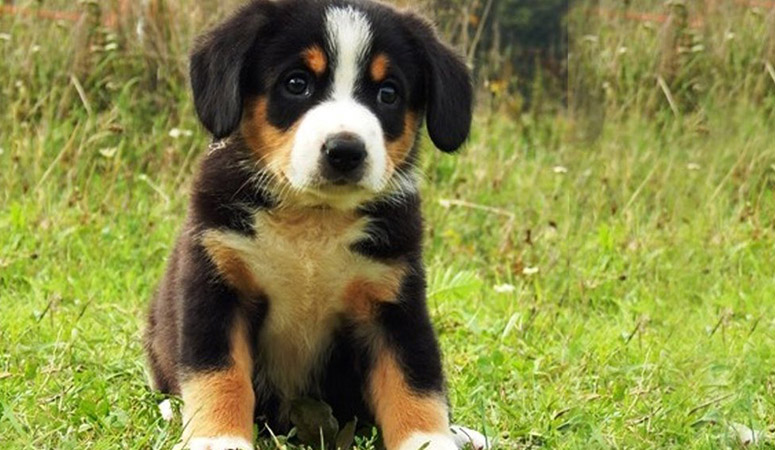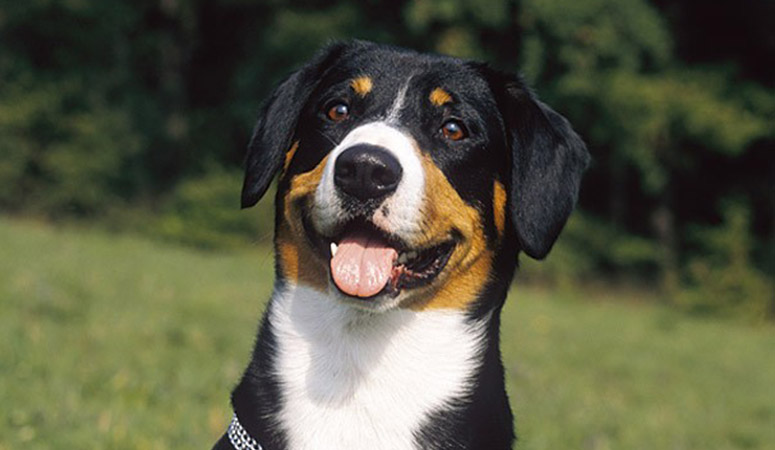Entlebucher Mountain Dog
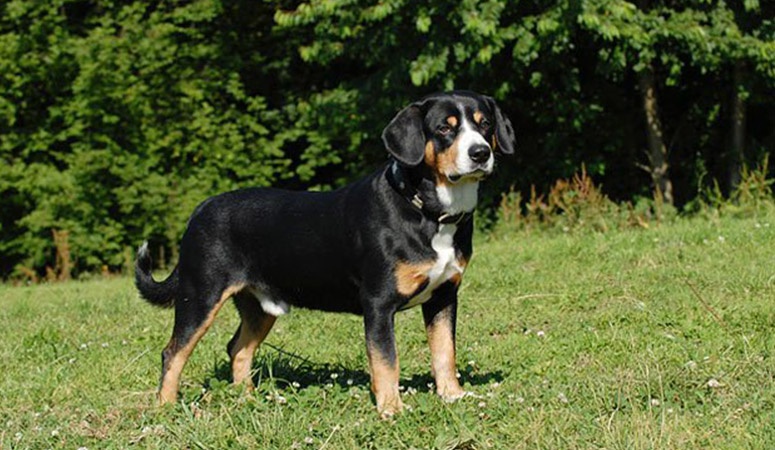
The Entlebucher Mountain Dog is the smallest of the four Swiss Mountain and Cattle Dogs, named after the valley of Entlebuch. He is a medium-sized herding dog with short, sturdy legs and strong muscle. They are known for agility, balance, and boundless enthusiasm, and need lots of exercise, family time, and direction to reach their full potential.
| Other Names | Entelbuch Mountain Dog, Entelbucher Cattle Dog, Entelbucher Mountain Dog, Entlebuch Cattle Dog, Entlebuch Mountain Dog, Entlebucher |
| Color | Black, Black White & Tan |
| Height | Males: 17-21 inches. Females: 16-20 inches. |
| Weight | Males: 55-65 pounds. Females: 55-65 pounds. |
| Life Span | 11-13 years |
| Personality | Loyal, Smart, Enthusiastic |
| Exercise | Needs Lots of Activity |
| Origin |
| Popularity | #167 |
| Groom Needs | Occasional Bath/Brush |
| Kids Friendly | Yes with supervision |
| Dog Friendly | Yes |
| Watch Dog | Yes |
| Family Dog | |
| Litter Size | 7-8 puppies |
Entlebucher Mountain Dog Pictures
Entlebucher Mountain Dog Video
Introduction
Entlebucher Mountain Dogs are good-natured companions of the house, active and large enough for the hard jobs that come from time to time. Generally, they have a square build although the females are more squared. Entles have a well-proportioned head to their bodies and can get aggressive towards strangers. This breed requires lots of exercises as they are very active and energetic. They come in a tricolor of black, with white markings and tan (or mahogany). The coat is short, hard, and shiny.
A standard male of this breed stands 17-22 inches from shoulder to paw and weighs around 50-65 pounds. A similar female should stand between 15 and 20 inches at the shoulder and tip the weighing scale at 40-55 pounds. They belong to the Herding Group, and would normally span a period of 10-13 years before they eventually die.
Living with Entlebucher Mountain Dog
With dense, short, shiny double coat, the Entlebucher requires minimal grooming overall. They need little more than a wipe-down with a damp towel between baths to stay in optimum appearance.
Brush the dog weekly with a rubber curry brush to remove dead hair. The breed sheds quite a bit, so you may want to invest in a good stripping comb or a thick bristle brush to keep shedding to a minimum.
Nails should be trimmed weekly or only monthly to keep them short. Short, neatly trimmed nails keep the dog’s feet in good condition and keep your legs from getting scratched when your Entlebucher enthusiastically jumps up to greet you. Handle his paws frequently — dogs are touchy about their feet — and look inside his mouth and ears.
Ears should be checked weekly. Cleaning out wax and debris can help avoid the ear infections that plague dogs with drop ears.
Dental care should be started early and maintained on a regular basis throughout your dog’s life.
Get your Entlebucher accustomed to being brushed and examined when he’s a puppy. Make grooming a positive experience filled with praise and rewards, and you’ll lay the groundwork for easy veterinary exams and other handling when he’s an adult.
Entles are active dogs that like to run and roughhouse. It will take at least an hour of exercise daily to keep him in good physical condition.
They need a good, long play period or hike daily, plus activities such as agility, obedience, or tracking to challenge their mind.
Since a “tired dog is a good dog,” keeping the breed’s energy channeled through exercise will make training and simply living with him much easier.
The yard has to have a tall, solid fence, and the walk has to be on a leash, because they will chase after any small animal they smell.
When left alone for long stretches, they can become destructive or aggressive. When you must go to work, it would be wise to leave toys out that require the dog to figure out how to get the treat hidden within.
Entles love doing things with their owners so make excellent companions for runners, hikers, bikers, and other very active people. It is also beneficial for these dogs to have a meaningful task to which they can devote themselves to.
The Entles should do well on a high-quality dog food, divided into two meals.You should consider only diet formulated to your dog’s age and activity level.
The quality of dog food you buy also makes a difference — the better the dog food, the further it will go toward nourishing your dog and the less of it you’ll need to shake into your dog’s bowl.
A working dog requires a different formula than a sedentary house pet, and a puppy requires different nutrition than a senior pet.
This is a breed who loves to eat and thus can be prone to becoming overweight if you don’t monitor his food intake closely. If you choose to give treats during training, do so in moderation. Treats can be an important aid in training, but giving too many can cause obesity in any breed.
Clean, fresh water should be available at all times.
Learn about which human foods are safe for dogs, and which are not. Check with your vet if you have any concerns about your dog’s weight or diet.
Most Entlebuchers are healthy dogs, but there are a few disorders the breed can be prone to, such as hip dysplasia, luxating patellas, eye disorders and Entlebucher urinary syndrome (a condition involving the misplacement of the ureter), etc.
Not all Entlebuchers will get any or all of these diseases, but it’s important to be aware of them if you’re considering this breed.
The dog’s ears should be checked regularly for signs of infection, and the teeth should be brushed often, using a toothpaste designed for dogs.
There are several health tests considerations specific to the breed, such as hip evaluation, patella evaluation, PRA Optigen DNA test and ophthalmologist evaluation.
Responsible breeders test all breeding stock for conditions that can affect the breed. Regular visits to the vet for checkups and parasite control help to ensure the dog a long, healthy life.
Total Annual Cost: $2889
Cost is estimated for the first year and may vary depending on many factors, such as dog food, health care, leash, collar, licensing, possible fencing, crates, training and obedience classes, dog-walking, grooming, treats, toys, flea, tick, and heart-worm meds, microchips, etc.
Entles are smart, versatile workers who are very rewarding to train and they are extremely eager to please their masters. They love having a job to do and are excellent candidates for obedience, tracking, agility, herding and almost any other canine sport.
They are highly trainable and respond extremely well to positive reinforcement based training techniques. They are quite independent and capable of making decisions by themselves and require consistent leadership.
If lack of leadership, the Entlebucher Mountain Dog can often feel the need to assume a leadership role within its human pack which in turn can lead to various behavioral problems.
Early socialization is extremely important with this breed. They are very intelligent, so any training routine should include fun and variety to keep them from getting bored.
He loves his kids but, because he also loves roughousing, he must learn to be gentle with little ones. He may try to “herd” his kids by nipping at their heels.
History
Switzerland has built quite a reputation for dairy and cattle products– meat, milk, cheese, and some chocolates. For centuries, Swiss farms and pastures have been occupied by grazing livestock, which generated a significant bulk of revenue. As would be expected in such farming practices, a herder or shepherd had to be involved. The Senn people of the region had their own share of agrarian life and were popular for their herding dogs which were of four distinct breeds, namely the Greater Swiss Mountain Dog, Bernese Mountain Dog, Appenzeller Mountain Dog, and Entlebucher Mountain Dog. They are collectively referred to as the Sennenhund-type dogs, of which the Greater Swiss Mountain Dog is the largest, and the Entlebucher Mountain Dog, the smallest. They are mountain dogs, all believed to have originated from molosser dogs brought into the region by the Romans, about 2000 years ago.
The Entlebucher Mountain Dog had originated in the valley of the Entlebuch river, where it was bred mainly to herd cattle and guard farmsteads. They were so hard-working and zealous that they earned a nickname synonymous to “Laughing Dog”. The breed was well recognized in Switzerland and was registered into the Swiss Kennel Club Studbook. However, the First World War decimated their numbers and by the end of the war, there was hardly any dog to continue the bloodline of the Entlebucher Mountain Dog. Later in 1926, a breed club was founded in Switzerland, and, by 1927, breeding restarted with a few members collected across Switzerland. The Entlebucher Mountain Dog was recognized by the American Kennel Club in 2011.
Helpful Information
Breed Club: NATIONAL ENTLEBUCHER MOUNTAIN DOG ASSOCIATION
Breed Club Link: https://nemda.org/
Breed Club Rescue: NEMDA Rescue
Breed Club Rescue Link: https://nemda.org/available-dogs/

